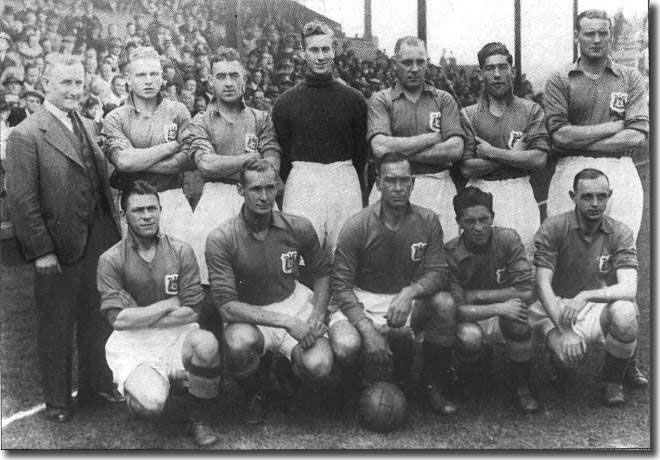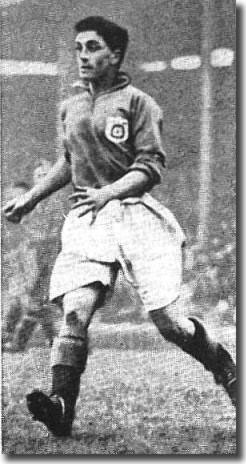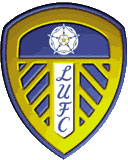|
 Leeds
were lucky to escape from relegation at the end of 1936/37
and it was only by winning the last two games that they were able to ensure
safety. The arrival of South African centre-forward Gordon Hodgson in
March had made all the difference and manager Billy
Hampson hoped that the last-minute improvement in form could be maintained
in the new season. Leeds
were lucky to escape from relegation at the end of 1936/37
and it was only by winning the last two games that they were able to ensure
safety. The arrival of South African centre-forward Gordon Hodgson in
March had made all the difference and manager Billy
Hampson hoped that the last-minute improvement in form could be maintained
in the new season.
He didn't bring in any new players during but the summer saw three notable
departures from Elland Road: veteran keeper Albert McInroy went back to
his native North East and non-league football with Gateshead after losing
his place to Reg Savage at the tail end of the previous season; full-back
George Milburn had been similarly ousted, by young England full-back Bert
Sproston, and was off to Chesterfield after 157 appearances in an Elland
Road career that had lasted almost ten years; and the masterly schemer
Billy Furness departed after nine years, 243 matches and 62 goals on a
£2,700 transfer to Second Division Norwich.
All three had been popular players at Leeds, but the emergence of youngsters
like Sproston (23), Eric Stephenson (22), Savage (25), James Makinson
(24), Tom Holley (23), Bobby Browne (25), George Ainsley (22), Arthur
Buckley (24), John Thomson (21), Jack Hargreaves (23), David Cochrane
(16), Dominic Kelly (20) and Cliff Francis (21) brought an exciting feel
to Elland Road and the time was right to move on. Before Christmas, Hampson
added others like left-half Bill Parry (20), inside-forward Gerry Henry
(17), winger Billy Heaton (19) and Irish keeper Jim Twomey (23). Leeds'
young reserves had won the Central League for the first time in 1937 and
many of that squad made their first-team breakthrough in 1937-38.
Of the side that kicked off the new season with a 1-1 draw at Charlton,
only Jack Milburn, Sammy Armes (both 29) and Hodgson (33) were over 25.
The side was unchanged for the first eight matches as they opened in strong
form, suffering just one defeat, by 4-1 away to Chelsea. They were riding
high and even the enforced absence for four matches of Hodgson was only
a minor setback. Leeds won only one of those four matches, but Hodgson
announced his return on 30 October at Leicester by slotting home his sixth
and seventh goals of the season in a 4-2 victory.
The defence looked much more solid, with Sproston and Jack Milburn regular
partners at full-back and Holley, bought from Barnsley in July 1936, restoring
some authority at centre-half. Makinson and Browne were sturdy, if unspectacular,
wing-halves. Replacing the injury-prone Arthur Hydes, South African Hodgson
scored 25 goals in 36 games and was ably partnered at inside-left by the
stylish Eric Stephenson, a rising star who by the end of the season was
called up to play for England, making his debut in a defeat against Scotland,
with Sproston's presence making him feel at home.
Stephenson was proving an outstanding discovery and had fully justified
Hampson's faith in releasing Furness - he had made the No 10 jersey his
own. His hat trick in the 4-3 home win over Sunderland on 4 December was
right in the middle of a spell of seven goals in seven games as Leeds'
excellent form continued in the run up to Christmas.
Leeds beat Chester 3-1 in the third round of the Cup on 8 January, but
by the time they got to the fourth round at Charlton on 22 January, their
form had deserted them. Charlton's 2-1 win represented the third defeat
in four games and, in fact, Leeds only won twice between a 5-3 Christmas
Day victory over Middlesbrough and a narrow 1-0 win at Stoke on 18 April, when an own goal ended a spell of four games without
scoring. During this 16-game run, Leeds managed just 11 points and 18
goals, but there was a remarkable 4-4 home draw with Everton in which
Hodgson scored all four.
Stoke on 18 April, when an own goal ended a spell of four games without
scoring. During this 16-game run, Leeds managed just 11 points and 18
goals, but there was a remarkable 4-4 home draw with Everton in which
Hodgson scored all four.
Any dreams they harboured of seriously challenging for the title were
dashed during that period, but they followed up the victory at Stoke with
two victories and the 4-0 demolition of well-placed Brentford on 23 April
saw Hodgson hit another hat trick. His goal in the next match, a 6-2 defeat
at Manchester City, was his 25th in the league, making him far and away
the top scorer. The win couldn't help City avoid relegation just a year
after being league champions, but when Leeds completed their programme
with a 4-0 final day defeat at Portsmouth, Pompey were able to secure
First Division survival for another year.
Despite the poor run during February and March, Leeds managed
to finish the season in the top half of the table. If they had
managed to win those two games against the threatened teams, United
would have risen to the dizzy heights of fourth, behind Arsenal
(securing yet another title in this, their golden decade), Wolves
and Preston.
Such relative success after the ineptitude displayed in 1936/37 saw the
average gates at Elland Road rise to nearly 22,000, the highest they had
been since 1929. The Christmas Day defeat of Middlesbrough drew more than
37,000 fans. Leeds had now had six straight seasons in the top flight
and had only been out of Division One for two seasons since they won the
Second Division title back in 1924. It was starting to feel like Leeds
were almost permanent fixtures at football's top table.
Other Football Highlights from 1937/38
- In an unusually close First Division campaign, only 16 points separated
champions Arsenal (52) from the relegated pair Manchester City and WBA.
Wolves, top by a point as the season went into its last day, lost 1-0
at Sunderland, while Arsenal beat Bolton 5-0 to take their fifth title
in eight years. But the biggest drama was unfolding at the other end
of the table. On Cup final day, a week before the end of the season,
any of the bottom 11 teams could have been relegated, including Cup
finalists Huddersfield. The last day saw six teams joint bottom with
36 points. Birmingham got out of trouble with a 4-1 win at Leicester,
while Grimsby, Portsmouth and Stoke all had home wins. The crucial match
was Huddersfield v Manchester City. Huddersfield won 1-0 to stay up
and doom City, First Division top scorers (80 goals) and champions a
year earlier
- After 119 minutes of dull, featureless football, the Cup final between
Huddersfield and Preston was decided by the first penalty ever to be
awarded in a Wembley final. It was also the first time that extra-time
had been required at the stadium. Preston's Scottish international inside-right,
George Mutch, won the match when he slammed the ball in off the cross
bar with the last kick of the match
- The Nazis had only just annexed Austria when England arrived
in Berlin to play Germany at the start of their end of season
tour of Europe. The England team obeyed orders in giving a Nazi
salute to Hitler's henchmen despite misgivings from many of
the players. On a sweltering afternoon in May, England showed
their mastery with a 6-3 win. Leeds' Bert Sproston was in the
team
- The 1938 World Cup finals were held in France and holders Italy retained
their title by beating Hungary 4-2 in the final in Paris on 19 June.
The British nations still refused to play despite desperate pleas from
FIFA and Brazil were the only South American team to compete, finishing
third. The only other non-European entrants were Cuba and the Dutch
East Indies
back to top
|












 Leeds
were lucky to escape from relegation at the end of 1936/37
and it was only by winning the last two games that they were able to ensure
safety. The arrival of South African centre-forward Gordon Hodgson in
March had made all the difference and manager Billy
Hampson hoped that the last-minute improvement in form could be maintained
in the new season.
Leeds
were lucky to escape from relegation at the end of 1936/37
and it was only by winning the last two games that they were able to ensure
safety. The arrival of South African centre-forward Gordon Hodgson in
March had made all the difference and manager Billy
Hampson hoped that the last-minute improvement in form could be maintained
in the new season. Stoke on 18 April, when an own goal ended a spell of four games without
scoring. During this 16-game run, Leeds managed just 11 points and 18
goals, but there was a remarkable 4-4 home draw with Everton in which
Hodgson scored all four.
Stoke on 18 April, when an own goal ended a spell of four games without
scoring. During this 16-game run, Leeds managed just 11 points and 18
goals, but there was a remarkable 4-4 home draw with Everton in which
Hodgson scored all four.